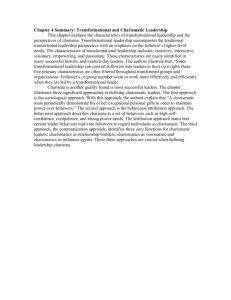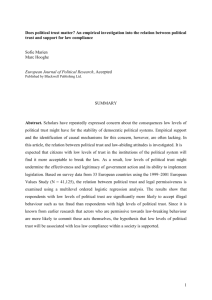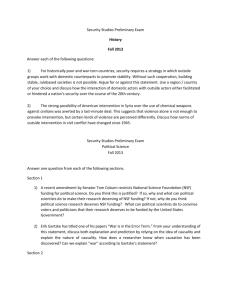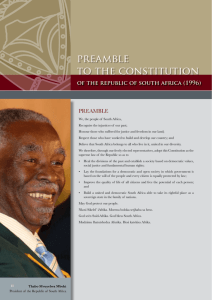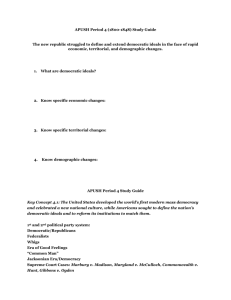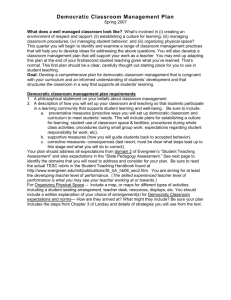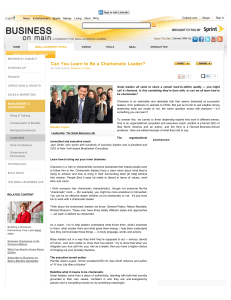Historical Development of Educational Management
advertisement
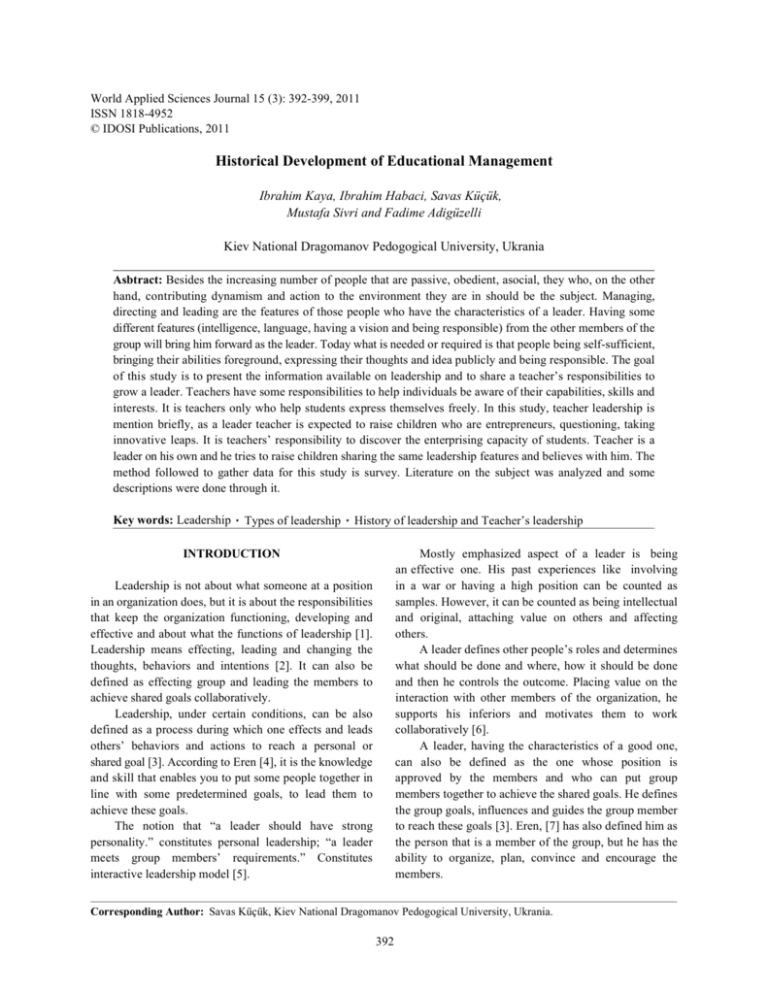
World Applied Sciences Journal 15 (3): 392-399, 2011 ISSN 1818-4952 © IDOSI Publications, 2011 Historical Development of Educational Management Ibrahim Kaya, Ibrahim Habaci, Savas Küçük, Mustafa Sivri and Fadime Adigüzelli Kiev National Dragomanov Pedogogical University, Ukrania Asbtract: Besides the increasing number of people that are passive, obedient, asocial, they who, on the other hand, contributing dynamism and action to the environment they are in should be the subject. Managing, directing and leading are the features of those people who have the characteristics of a leader. Having some different features (intelligence, language, having a vision and being responsible) from the other members of the group will bring him forward as the leader. Today what is needed or required is that people being self-sufficient, bringing their abilities foreground, expressing their thoughts and idea publicly and being responsible. The goal of this study is to present the information available on leadership and to share a teacher’s responsibilities to grow a leader. Teachers have some responsibilities to help individuals be aware of their capabilities, skills and interests. It is teachers only who help students express themselves freely. In this study, teacher leadership is mention briefly, as a leader teacher is expected to raise children who are entrepreneurs, questioning, taking innovative leaps. It is teachers’ responsibility to discover the enterprising capacity of students. Teacher is a leader on his own and he tries to raise children sharing the same leadership features and believes with him. The method followed to gather data for this study is survey. Literature on the subject was analyzed and some descriptions were done through it. Key words: Leadership Types of leadership History of leadership and Teacher’s leadership INTRODUCTION Mostly emphasized aspect of a leader is being an effective one. His past experiences like involving in a war or having a high position can be counted as samples. However, it can be counted as being intellectual and original, attaching value on others and affecting others. A leader defines other people’s roles and determines what should be done and where, how it should be done and then he controls the outcome. Placing value on the interaction with other members of the organization, he supports his inferiors and motivates them to work collaboratively [6]. A leader, having the characteristics of a good one, can also be defined as the one whose position is approved by the members and who can put group members together to achieve the shared goals. He defines the group goals, influences and guides the group member to reach these goals [3]. Eren, [7] has also defined him as the person that is a member of the group, but he has the ability to organize, plan, convince and encourage the members. Leadership is not about what someone at a position in an organization does, but it is about the responsibilities that keep the organization functioning, developing and effective and about what the functions of leadership [1]. Leadership means effecting, leading and changing the thoughts, behaviors and intentions [2]. It can also be defined as effecting group and leading the members to achieve shared goals collaboratively. Leadership, under certain conditions, can be also defined as a process during which one effects and leads others’ behaviors and actions to reach a personal or shared goal [3]. According to Eren [4], it is the knowledge and skill that enables you to put some people together in line with some predetermined goals, to lead them to achieve these goals. The notion that “a leader should have strong personality.” constitutes personal leadership; “a leader meets group members’ requirements.” Constitutes interactive leadership model [5]. Corresponding Author: Savas Küçük, Kiev National Dragomanov Pedogogical University, Ukrania. 392 World Appl. Sci. J., 15 (3): 392-399, 2011 A leader is a creative person who can handle the situations they are in and the groups he is working with well and make benefit of situations for both himself and his group without having any intention or goal of promotion or prize and make people believe in their shared goals for which they try to reach. He is also a person who controls and who is controlled [8]. Each individual lives his fate, but he is in an interactive environment with others, which is an indispensable aspect of social life. The individual interacting with others and acting with them and on his own has specific characteristics. Each individual in optimum condition is expected to do these all. Leaders are members of this social environment, but they are supposed to have some more features that everybody in the society so as to let them follow. It can be said that everybody is, somehow, a leader; however, a real one should have some special skills or characteristics to make other follow him. These can be listed as follows Can [11]: Characteristics of a Leader: According to Özel [9], a leader is aware of the difference between power and authority. Power or government is the ability to get someone to do a task and to control inferiors. However, authority is the power or right that is legitimized or accepted by the inferiors. The real leadership lays behind the balance between power and authority, having a legitimized and approved statues. A perfect physiology, a good parental background and wealth provides more opportunities for those who want to be a leader today; however, these are not enough to be a leader [10]. Especially the leaders in education must have more qualifications than these above mentioned. Those abovementioned qualifications should not be expected to be in a leader. Nevertheless, it can be said that one having as many of the qualifications as possible has more chance to be a leader. A leader may take risk if it is required, but he, at the same time, should be aware of what he did. When he doesn’t know possible outcomes of a risky action, or if the outcomes are not acceptable and negative, he may lose others’ respect and credibility. Focuses on long-term goals and foresees the future. He is innovative and open to change. He is a part of the whole group and sensitive to others. His thoughts and ideas emphasize the big picture, but no parts of it. He is passionate what he does and will do. He motivates others and believes that reasoning and logic are essential. He provides more than one option and aims to act on shared goals. He provokes strategic thinking. He expects mates to be loyal and allegiance to principles and ideals. His authority is approved and accepted through his expertise and modeling. Characteristics of a Leader Figured out according to Some Research No Year Author/Researcher Characteristics of a Leader 1 2 1993 1993 John ADAIR Francis YAMMARINO 3 4 1996 1990 Bernard BASS & B.J. AVOLIO Ruth TAIT Innovator, mentor, enabler, motivator, energetic, communicator Individualized Consideration, Intellectual stimulation, Inspirational Motivation, Idealized Influence. Ability to Influence Visionary, Communication Skills, Introverts, Character/Integrity, Ambition, Commitment, Independence. 5 1979 1989 G. TIBBITS B. BIRD 6 1961 1990 1992 1998 7 1998 D.C. McCLELLAND J.B. ROTTER K. VESALA K.G. VIVIEN & S.THOMPSON Joe JORDAN & Sue CARTWRIGHT 8 2000 Montserrat ENTRIALGO Innovativeness, Taking Risks, Professional Knowledge, Ability to Co-operate, Internal Locus Of Control Internal Locus Of Control Emotional Stability, Self-reliance, Intellectual Competencies, The Absence Of Dogmatism, Communication Skills, Low Neuroticism, Ability To Handle Stress. Need For Achievement, Tolerance For Ambiguity, Internal Locus Of control, Proactive. [12] 393 World Appl. Sci. J., 15 (3): 392-399, 2011 What Are the Components of Leadership?: Within a functioning community, each individual is influenced by the others and he has an impact on the others as well. This interaction exists in every community naturally and generally common. Within this mutual effect, some individuals affect the community more than others. For such situations, these people’s varying features that create a difference should be emphasized. Of the characteristics of leadership, tea work skills, manner creating difference and some other personal skills can be counted. Ability is the capacity to do something or complete a task well and if it is learned, then, the skills, like speaking, discussion and planning, can be improved as well. Personal leadership style is important too and it can be either democratic or autocratic, extrovert or introvert, active or passive, enterprising or stable [9]. Though all leaders don’t share the same characteristics, it can be claimed that they have some common ones which aren’t difficult to define. On the other hand, someone having a good deal of leadership characteristics don’t essentially need to be a leader. Therefore, it can also be stated that having these characteristics is essential, but not enough. Leadership can be defined as a process, in certain conditions and for some predetermined personal or group goals, in which a person has a guiding and leading influence on others’ behaviors and actions. Thus, it is a process that is about what the leader does. It is not a must to have a formal organization to form a leader; however, when a certain group follows a person for a group of certain goals, leadership process begins. It doesn’t need to be formal. For instance, among students in the classroom, there are some groups which are not constituted with a purpose but which are formed on their owns. Within these groups, none publicizes a member as the leader or the head of the group. In a group formed by the hardworking students in a classroom, the leader will most probably the student who is the most hardworking one in the group. As another example, it can be claimed that when a football tournament is organized at school, the best player of the team will be the leader or the captain of the team. A leader is open to the influence of group members, but he, attracting their attention, puts their energy together and directs it to a certain and desirable goal [13]. A leader is the person in the front of the group and he has a reasonable approach to the cases and he is the first person explaining what should be done. As underlying fundamental principle of the leadership, he has original perspectives and tolerance for ambiguity and he puts consistent ideas against complex situations forward. Leadership involves foreseeing the future of the organization, presenting visionary and trustworthy ideas and goals and making people he works together believe them and act together to reach them [14]. Leadership covers a certain period and the leader, as the only person, organizes the group members around certain goals, distributes tasks or responsibilities to the members and motivates them. A leader having a perspective different from group members is an organizer has to work hard in line with the goals. As people are social and have to live in communities, they need someone to lead and help them reach their goals as leaders [7]. When the common definitions of leadership are examined, it is the point that a leader has different characteristics from group members. A leader constantly works for group’s goals and he postpones his personal goals for the sake of group’s goals. A leader is in the front of the group when it is dedication, taking risks and responsibilities. When the goals are achieved and it is time for prizing, he can be said to be back rows. A leader, however, who leads a group for his goals and ambitions will likely face up with antibehaviors or rebellious acts of the group members – especially when he loses his power and force and when goals aren’t achieved. What Leadership isn’t: Leadership isn’t a position for discrimination Leadership is a process, not a position. Ledars are team members and it is not a solo performance. Leadership isn’t dispensible. Leadership doesn’t mean accusing others. Leadership isn’t a standard, never-changing position. Leadership isn’t a composition of in-birth skills. Leadership doesn’t mean ruling people. Leadership doesn’t mean creating a new personality or culture. [15]. Historical Perspective of Leadership: With advances in science and placing more importance on education, communities and especially people were started to be questioned. After the emergence of natural thoughts and freedom of thought, man and his ideas and thought were examined. Those people who were examined were the persons of their age, or they were leaders. However, deos a leader have any differences? If there is, what makes him different? How did he become a leader? What should be done to be a leader? These questions and simiar ones emerged with the examination of people who had leadership personalities. 394 World Appl. Sci. J., 15 (3): 392-399, 2011 Development of Leadership Institute Years Till the 1940s 1940–1960 1960–1980 The 1980s Leadership Institute Privacy Theory Behavioristic Theory Situational Theory New Approaches Quatos of Institute Leadership is an in-birth characteristic. Efficiency of a leader is dependent on how he acts. An efficient leader is susceptible to the condition. A leader has a vision. When this table is examined, leadership is perceived as in-birth caharacteristic. In previous societies, a leader was believed to have the authority from the God, which was named as “kut”. Later, a leader’s behaviors were examined and it was induced that a leader of this age should have plans for the future. In fact, after the collapse of authratic regimes and educating people to rule the countries, it became a point of study to examin and analyse the persons shaping the history. Leadership Approaches Approach Period 1. Personality 1907–1947 Features 2. Behavioristic The 1950s and 1960s 3.Situational The 1950s Early years of 1980s 4. Contemporary Mid of the 1920s Leadership after 1977 Theories Impression /Charisma Transformational After the 1978sLeadership, Servant Leadership, Follower Theory) [16] Main Assumptions A leader has some extra-ordinary and granted features. Some people have natural talent to direct. Leaders have some features different from their followers. There is only one possible way for the leadership. Those who are concerned about others, production and structure will be leaders. Leaders act differently in various situations and situations determine who will be the leader. Different situations require different leadership characteristics. Ladership is both a social and communicative process. The impact of charisma on leader-follower should be investigated more.- Leadership is an interactive process and requires sharing. Followers should be cared. Types of Leadership: According to Goleman, Boyatzis ve McKee [17], there are siz types of leadership. Four of them – visionary, training, affliative and democratic- have a motivating effect, while the rest two – pace-setting and commanding – have positive impact in certain conditions, but are implemented with great care. The visionary leader that moves people towards a shared vision and the coaching leader connecting wants to organizational goals and the affiliative leader creating people connections and thus harmony within the organization and the democratic leader acting to value inputs and commitment via participation, listening to both the bad and the good news and the pace-setting leader building challenge and exciting goals for people, expecting excellence and often exemplifying it themselves and the commanding leader soothing fears and giving clear directions by his or her powerful stance, commanding and expecting full compliance are the styles determined by Goleman and his friends [18]. Max Weber is also known as one of the well-known scientist classifying leaders according to their styles and features. Types of leader and types of authority are classified as follows [10]; Main Assumptions Conditions aren’t concerned in this approach since many personality features are too abstract to measure or observe. Studies are not related to the personality features. Many such studies ignore the motivation of a leader and his followers as it is a relative variable. Situational variables and group processes aren’t concerned and study to determine a certain leadership behavior have always been a failure. That many theories are failures makes suggesting certain and testable assumptions difficult. Theories don’t have clearcut measure or frames. Due to lack of researches on charismatic and transformational leaderships need clarifying. Cooperation, transformation and empowerment processes are difficult to control and measure. Authoritative Leader (Traditional Authority) Democratic Leader (Rational-legal authority) Charismatic Leader (Charismatic Authority) Classifiying a leader into these groups is resulted both from personality and from the perspective he has to rule the community he is in. That someone with a bad temper would be an authoritative or someone open to criticisim and new ideas would be democratic, or one with special talents would be a charismatic leader is the point we can reach. Authoritative Leader: This type of leaders is mostly seen in feudal societies and what such a leader will be determined by the traditions or norms. When he overgoes the limit or doesn’t obey the norms, he has to face some sanctions. Within these societies, leaders are also the religious leaders. An authoritative leader determines group policies and he is the final office deciding on the penalties and awards. He is indispensable for the group and sets the interaction among the members. He can keep anyone questioning his authority and decisions away from the society and he holds all the power and authority in his hand. 395 World Appl. Sci. J., 15 (3): 392-399, 2011 Ar kan [19], as the Characteristics of Authoritative Leaders, Puts These Forward: making mistakes, they won’t do anything. They will not ask question because of criticism and reactions from the teacher and they will not find answers to their questions. They will be over-dependent and will not act on their own. They will do their homework or complete tasks only for that their teacher who is the leader here asks them to. New ideas will never come out and a society whose members cannot be sure about themselves will emerge. The teacher will lead to raise a generation who is totally dependent on others. An authoritative leader determines the policies and goals of the group himself. An authoritative leader determines himself what will be done and how it will be done. An authoritative leader excludes his self from the group performance. An authoritative leader has a negative or positive personal attitude towards his inferiors. An authoritative leader only commands and wants the group members to fulfil them. He awards people acting in line with his orders and punishes those who don’t obey. His authority relies on his power and he doesn’t need to justify his orders and he doesn’t accept any suggestions of offers. He acts totally free while awarding and he can criticize member without any reason. This type of leader is really far from democracy and participation. Democratic Leader: According to Ergezer [10], democratic leaders are selected by the society. The main difference between a democratic leader and an authoritative one is the way he uses power or authority. A democratic leader tries to involve any individual in the process, he wants make decisions together with them because he values what others think or have as suggestions. According to Goleman and his friends [17], if the leader has a vision, his democratic attitude or style will enhance the process of emergence and production of new ideas that will help him reach and employ his vision. However, when he get over-dependent on these new ideas, it gets impossible to have confusion and reach a consensus. In addition, if he cannot adapt himself to various personalities, he can easily have wrong ideas. Democratic leadership, principally, has been accepted as a better one since it values participation and cooperation. Yet, it will not be wrong to say that it can change according to characteristics of the environment and the group members [4]. Democratic leader asks inferiors personally or as a group to join decision making process. What others have as suggestions is always important for him and there is an available environment for communication. He mostly encourages the others and he helps the group to reflect their features. Depending on these definitions, creating a democratic environment will contribute people to internalize democratic feeling and attitudes and emergence of individuals having self-esteem. Depending on these features, it can be conluded that leadership means having dominancy over group members. Authority is used only by the leader and there is a huge chain of command here. It is highlighted that rules are to be obeyed and they cannot be broken. There exist only orders and criticism done for mistakes and violence is possibly employed. Some examples of authoritative leadership behaviors can be counted like having dominance over workers, administering punishment, monitoring every act of students, controlling student performance, autocracy, close examination of learners and speaking more than listening [20]. Among authoritative leadership behaviors, “what should be done”, “how it should be done”, “when it should be done” and “who should do it” are the questions. Telling what he wants from the inferiors, planning and programming the process, controlling the goals and performances and expecting standard behaviors are common authoritative leader attitudes [21]. After the definitions and characteristics of authoritative leader have been dealt above, these are the possible outcome of a classroom in which the teacher is an authoritative one: He inhibits students acting freely in the classroom; students have to obey what was told them; otherwise, they will know that they will be punished, which makes them be constantly scared of, worried, or hesitant in the classroom. Due to the fear of Characteristics of a democratic leader are as follows [14]; Group policy is determined by involving group members into decision making process. A democratic leader shares the common ground with the members and for the technical information, he presents at least two options and asks them for their choice. 396 World Appl. Sci. J., 15 (3): 392-399, 2011 Distribution of responsibilities and task distribution should be under the responsibility of group members. A democratic leader should be objective about judging and criticism. A democratic leader should depend on the group members about any issue. Group members should feel free about any issue. Charismatic leaders emerge mostly when there is a social depression and the leader is seen as a savior for the people hopeless. The society believes and trusts him since the condition paves the way for this feeling. In Turkish history, Mustafa Kemal Atatürk is the best example who emerged when the society was in total collapse and in need of a leader. He, influencing the public with his charisma saved the country from a collapse. Charismatic leaders are directors with visions and missions. Some other features of a charismatic leader can be listed as respect, confidence and loyalty. These leaders had great influence on people and made their followers purify their personalities and characteristics [2]. Leader having charismatic power are at the same authoritative ones. Followers can ask for their ideas when they need guidance. They are like a guide and never make mistakes and they are inventors and followers assume them like that. However, continuous mistakes damage their charisma and make them lose it sooner or later. Yet, some still have their charisma after they die [10]. According to Weber, charisma is resting on devotion to the exceptional sanctity and heroism or exemplary character of an individual person and of the normative patterns or order revealed or ordained by him [24]. To have a democratic environment, punishment should not be the first option. About an environment a democratic leader creates, it can be claimed that he created an independent environment. What group members think is important for him and he is open to new ideas which are important and valuable form him. He involves group members into decision making process and he doesn’t need to organize them as they can organize themselves. Most of the tasks and responsibilities are shared with the members. While reaching a decision, everybody is in favor of the group. As members are aware of that they will not be punished, they can express themselves and their thoughts. Better ideas about the operation of the organization can come out. When a teacher had a democratic attitude, that previously confidence and peace will be the dominant feelings was mentioned. As in Maslow’s hierarchy of needs, an individual having esteem can express himself more comfortably. A student having this feeling will be a part of that class and belong to there. If the teacher asks students to study, they will do this with fun. They will ask questions easily and express themselves comfortably. Then, they will like to join decision making process actively and defend their thoughts. The most sticking feature of this leadership type is that the group can operate without a leader. However, for making decisions, the need for a leader is a must [22]. Depending on this explanation, it can be claimed that a teacher is required in the process of making decisions in a classroom. On the other hand, while deciding on a new rule for the class, participation of students should be essential. Each student has the chance to share his ideas and they reach a consensus which the teacher shares with students as the final decision. That means the teacher is the person who concludes the process. Charisma can be the power defined as a group’s perception and attributions; Through leaders quality and behaviors, Through the conditions leaders are involved and Through followers’ needs shaping and encouraging them to act for it [25]. Transformational leadership, in a sense defining charismatic leadership, is among the contemporary type of leadership. It is the type of leadership, charismatic, visionary, ethic, role model, intellectual and having motivating and inspiring influence on individuals and fulfilling workers’ needs and leading them to spend more effort for the goals to improve efficiency of the school [26]. Transformational leadership and charisma: for the development of transformational leadership, Weber has a great influence. Transformational leadership is defined in the same way and charisma has an important component of transformational leadership and plays a leading role in it [26,27]. Charismatic Leader: Charisma dates back to ancient Greek civilization and it means “"favor given" or "gift of grace”. Discussion about this term has been started by ancient age philosophers like Platon [23]. 397 World Appl. Sci. J., 15 (3): 392-399, 2011 Dimensions of Charismatic leadership Inspiring /Charismatic Builds vision and mission, emphasizes respect and honesty and performs amazing and confidential behaviors. Workers try to be like him. Inspires people around and motivates them. Has a positive future perception. Creates energetic and meaningful atmosphere. Inspirational Motivation Symbolizes professional practices and values, demonstrates high performance expectations and explains major goals simply Intellectual Stimulation Improves reasoning and logic and gets careful about problem solving. Motivates people to solve problems. Provides new perspective for the old methods. Supports creativity and innovations. Individualized Consideration Builds personal attention, guides workers, creates new opportunities to develop personal performance and considers the personal needs of employees. [26] Features of charismatic leader are listed below as follow [28]; 2. 3. Having supernatural power, High self-esteem, Able to attract and inspire others, Able to convince in parallel with the goals, Risk taking, Self scarification for the goal, Tolerating high cost to reach the goals, Considerate of the personal needs of followers, Developing radical solution in case of crisis, Persistency in his skills, Highly intelligent. 4. 5. 6. 7. When a person has the characteristics of a leader, he is supposed to be more skillful, intelligent, knowledgeable, motivating and energizing than a normal person. He should also be a good at public speaking and he should have intrinsic motivation. A teacher having charismatic leadership characteristics must be careful in the classroom since a charismatic leader is needed when the group or people are in need of immediate help. If students are total obedient to the teacher and do whatever he tells them, he must be more attentive as there will be many student imitating him. He must be a good role model as students do whatever they see in his behaviors. He can lead them reading by doing it in front of student 8. 9. 10. 11. 12. 13. He should build their self-esteem. He should motivate them in parallel with the goals. He should keep personal feeling in the second place. He should avoid behavior resulting in misunderstanding. 14. 15. 16. REFERENCES 1. 17. Karip, E., 1998. Dönü ümcü Liderlik, Uygulamada E itim Yönetimi, Y l;4, Say ; 16 (güz 1998), ss. pp: 443-465. 18. 398 Çelik, V., 2000. E itimsel Liderlik, Pegem Yay nlar ; Ankara. Sabuncuo lu, Z. and M. Ve Tüz, 1998. Örgütsel Psikoloji, Alfa; Bursa. Eren, E., 1989. Yönetim Psikolojisi. letme ktisadi Enstitüsü Yay nlar , stanbul. Ba ar, H., 2000. E itim Denetçisi. Pegem A Yay nc l k, Ankara. Bozbey, S., 1997. Durumsal Liderlik ve Türk Kara Kuvvetleri Alt Kademe Lider Tiplerinin ncelenmesi. Yay nlanmam Yüksek Lisans Tezi, zmir; Dokuz Eylül Üniversitesi, Sosyal Bilimler Enstitüsü. Eren, E., 1998. Örgütsel Davran ve Yönetim Psikolojisi, Beta Da t m; stanbul. Bennis, W., 1999. Bir Lider Olabilmek. (Çev; Umut Teksöz), stanbul; SistemYay nlar . Özel, M., 1998. Liderlik Sanat , z Yay nc l k; stanbul. Ergezer, B., 2003. Liderlik Ve Özellikleri, Ocak Yay nlar ; Ankara. Can, N., 2007. Ö retmen Liderli i ve Bu Becerilerin Gerçekle tirilme Düzeyleri, Soysal Bilimler Enstitüsü Dergisi; 22: 263-288s. Gökben-Çetin, N. and E. Beceren, 2007. Lider ki ilik; Gandhi, Süleyman Demirel Üniversitesi Sosyal Bilimler Enstitüsü Dergisi Y l/Volume; 3, Say /Issue, 5: 110-132 Ergün, T., 1992. Kamu Yönetimine Giri , TODA E Yay nlar , pp: 241. Ankara. i man, M. and S. Ve Turan, 2001. E itimde Toplam Kalite ve Yönetimi, Pegem A Yay nc l k. Ankara. University.http;//yayim.meb.gov.tr/dergiler/162/era slan.htm adresinden 25.05.2010 tarihinde eri ildi. Akis, Y.T., 2004, Türkiye’nin Gerçek Liderlik Haritas , Alfa Yay nlar , stanbul, Sayfa, pp: 15. Goleman, D., R. Boyatzis and A. McKee, 2002. Yeni Liderler, Varl k Yay nlar ; stanbul Goleman, D., 2000. Leadership That Gets Results, Hardward Business Rewiev, 78(2): 78-90. World Appl. Sci. J., 15 (3): 392-399, 2011 19. Ar kan, S., 2001. Otoriter ve Demokratik Liderlik Aç s ndan Atatürk’ün Liderlik Tarzlar Davran lar n n De erlendirilmesi, H.Ü. ktisadi ve dari Bilimler Fakültesi Dergisi, Cilt 19, Say 1. 20. Turan, S., 1998. A Study of Organizational Commitment in Human Organizations, Unpublished Doctoral Dissertation, Ohio; The Ohio 21. Peters, S.M., 2000. The Stational Leadership,; Hardcourt Brace Javanovich Publishers, USA. 22. Do an, S., 2001. Liderlik mi? Yöneticilik mi? Geleneksel Liderlik Davran Tarzlar ve Bu Konudaki Yeni Yakla mlara Bir Bak . Atatürk Üniversitesi . .Bilimler Fakültesi Dergisi, Cilt;15, Say ; 3-4, Erzurum, pp: 247-278. 23. Oktay, E. and H. Gül, 2003. Çal anlar n Duygusal Sa lanmas nda Conger ve Ba l l klar n n Kanungo’nun Karizmatik Lider Özelliklerinin Etkileri Üzerine Karaman ve Aksaray Emniyet Müdürlüklerinde Yap lan Bir Ara t rma, Sosyal Bilimler Enstitüsü dergisi. Selçuk Üniversitesi SBE. Dergisi, 10: 403-428. 24. K rel, Ç., 2001. Liderlik Davran Biçimleri Konusuna Yeni Bir Yakla m, Karizmatik Liderlikten Dönü ümsel Liderli e. Anadolu Üniversitesi Sosyal Bilimler Dergisi, 1(1): 43-49. 25. K l nç, T., 1996. Liderlikte Durumsall n Ötesi, Karizmatik Liderlik Yakla m , .Ü. letme Fakültesi Dergisi, 25(2)ss;2. 26. Bass, B.M., 1985. Leadership; Good, Better, Best, Organizational Dynamics, 13(3): 20-40 27. Collet, P. and A. Furham, 1995. Social Psychology at Work. London. Routledge 28. Cafo lu, Z., 1997.Liderlik; Bilgi-Karizma-De i im. 21. Yüzy lda Liderlik Sempozyumu (5-6 Haziran 1997), Bildiriler Kitab , Deniz Harp Okulu Bas mevi, Cilt-1, stanbul, 399

